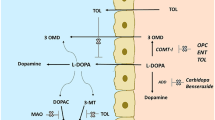Summary.
Two catechol-O-methyltransferase (COMT) inhibitors, entacapone and tolcapone, were developed during the 1990’s to be used as adjuncts to levodopa (LD) – dopa decarboxylase (DDC) inhibitors in the treatment of Parkinson’s disease (PD). Entacapone is currently in wide clinical use, while tolcapone can be used in restricted indications only, due to its hepatotoxicity. COMT inhibitors prolong the elimination of LD, while DDC inhibitors mainly increase its absorption; both mechanisms leading to increased bioavailability of LD. The pharmacokinetic properties of LD, carbidopa and entacapone are quite similar, and entacapone is administered concomitantly with LD plus carbidopa. Entacapone prolongs the clinical effect of each LD dose by 30 to 40 minutes; this effect is seen already after the first entacapone dose. When LD is administered in several frequent daily doses, addition of entacapone reduces the daily fluctuations of plasma LD by 30 to 40%.
Based on studies with home diaries, entacapone increases the daily ON-time by an average of one to two hours, and reduces the daily OFF-time correspondingly in patients with PD with motor fluctuations. The daily LD dose has been reduced by 10 to 30%. These positive effects are sustained in long term use over several years. There is still scant information of the benefit of entacapone in patients without motor fluctuations.
Entacapone can cause both dopaminergic and non-dopaminergic adverse events. Increased dyskinesias are most frequently recorded in patients with motor fluctuations. The dopaminergic adverse events can usually be diminished by reducing the LD dose. Non-dopaminergic adverse events are abdominal pain and diarrhea. Diarrhoea has led to discontinuation in 3 to 4% of the patients in clinical trials. Entacapone has not been connected to liver toxicity and there are no indications to follow laboratory safety during treatment. The benefit-risk ratio of entacapone is considered favorable.
A triple LD/carbidopa/entacapone combination tablet has recently been developed. Three LD strengths (50, 100 and 150 mg) are available, each contains 200 mg of entacapone. The majority of the patients can be managed with these three LD strengths. Entacapone has today an established position in treatment of PD patients with motor fluctuations, either as a separate tablet or as the triple LD combination.
Similar content being viewed by others
Author information
Authors and Affiliations
Rights and permissions
About this article
Cite this article
Gordin, A., Kaakkola, S. & Teräväinen, H. Clinical advantages of COMT inhibition with entacapone – a review. J Neural Transm 111, 1343–1363 (2004). https://doi.org/10.1007/s00702-004-0190-3
Received:
Accepted:
Published:
Issue Date:
DOI: https://doi.org/10.1007/s00702-004-0190-3




